#NASA history
Explore tagged Tumblr posts
Text

Lifting bodies were used by NASA to test the ability of wingless vehicles to land like a normal airliner from out of Earth's orbit. They were instrumental in developing the concept of the Space Shuttle.
Photo source: NASA Left to right: X-24A, M2-F3, and the HL-10
#nasa#nasa history#aeronautics#aviation#aircraft#space stuff#space history#aviation history#aeronautical history#these lil guys are so neat to me aaa
22 notes
·
View notes
Text
Major Robert Lawrence: The Man Selected to Be America’s First Black Astronaut
youtube
Though his untimely death meant he never flew above the von Kármán line (the official requirement for members of the US armed services to be awarded astronaut wings), Maj. Robert Lawrence (October 2, 1935 – December 8, 1967) was the first African-American selected for any national space program.

Bob Lawrence, a Test Pilot at Edwards in the mid-1960s, graduated from TPS Class 66B and was immediately selected as a member of the third group of aerospace research pilots for the Manned Orbiting Laboratory (MOL) program with three of his TPS classmates. Not only was he a superb test pilot, he also held a PhD in physical chemistry from The Ohio State University (the only MOL pilot with a Doctorate). Colleagues described him as a “super guy”... brilliant, humble, and charming. The MOL was a joint project of the Air Force and the National Reconnaissance Office to obtain high-resolution photographic imagery of adversaries during the American Cold War.
At the press conference announcing the selection of the MOL Group 3 pilots, Maj Lawrence laughed when asked “Will you have to sit in the back seat of the capsule?” He was also asked if his selection was historic for race relations in the United States. His humble answer was characteristic: “No, I don't think so. It's another one of those things that we look forward to in civil rights -- normal progression.” He said that he had faced problems like other black people, but “Perhaps I have been more fortunate than the others in the opportunities.”
MOL was a classified United States Air Force & National Reconnaissance Office (NRO) project to put a series of mini-space stations in low-polar orbit to conduct advanced surveillance during the Cold War. The stations would launch on Titan IIIs, be occupied by 2-man crews for 30 days, then return in Gemini capsules. A test flight was successfully launched in 1966, but the program was canceled in 1969 by the incoming Nixon administration. When the program was cancelled, the MOL astronauts transferred to NASA and became part of the Shuttle program. Had he lived, there is little doubt Bob Lawrence would have joined them, piloting one of the first Space Shuttle missions of the 1980s.
Tragically, his contributions to spaceflight ended too soon. On 8 Dec 1967, while teaching another test pilot the low-L/D (steep descent glide) landing technique that was later used for Space Shuttle landings, Lawrence was killed in an F-104 crash at Edwards AFB. During the steep approach to the lakebed runway, Maj Harvey Royer initiated the flare too late and the F-104 impacted the runway hard, collapsing the main gear and causing the F-104 to skid and roll down the runway. Royer survived the ejection with major injuries; Lawrence was killed due to the delay in the rear-seat ejection sequence. Ironically, Lawrence had indeed been sitting in the back just as the reporter had joked - not because of his race, but because the back seat of the aircraft is where the (more senior, in a position of authority) instructor pilot sits.
Thirty years after his tragic death, on 8 Dec 1997, Robert Lawrence Jr’s name was engraved on the Space Mirror Astronaut Memorial at Kennedy Space Center. In 2017 on the fiftieth anniversary of his death, NASA honored Maj Lawrence once more, with his former classmates and MOL astronauts sharing memories of his flying skills, brilliance, intelligence, courage, and character. Former NASA Administrator and four-time shuttle astronaut Charles Bolden, who benefitted from the shuttle landing flare technique that Robert Lawrence developed at Edwards AFB, remarked at the ceremony:
“He was the First--but definitely not the Last!”

Lawrence (front row, third from the left) was a member of USAF TPS class 66B. He was the 809th alumni to graduate from the school, and the first black man to do so. In this class photo, he poses with his classmates in front of an F-104, the same model of aircraft he was killed in.

Lawrence (far left) taking notes in class (photo taken from the USAF TPS 35 anniversary yearbook).

Bob Lawrence and his wife Barbara pose with classmates and their spouses at Test Pilot School graduation.
#black history month#Youtube#major robert lawrence#NASA history#military history#astronauts#most of this information came from an official email sent to Edwards AFB personnel this week in spite of Trump’s executive orders#“we aren’t supposed to honor minorities anymore b/c new rules but anyway here’s some interesting historical info that’s just interesting”#the low L/D flight profile he helped develop is still taught and flown at air force test pilot school (though they no longer use F-104s)
7 notes
·
View notes
Text
The maths needed to fly to, and land on, the moon? Women mathematicians did it, and by hand. They were called computers. The meaning of that word has changed since the 1960s
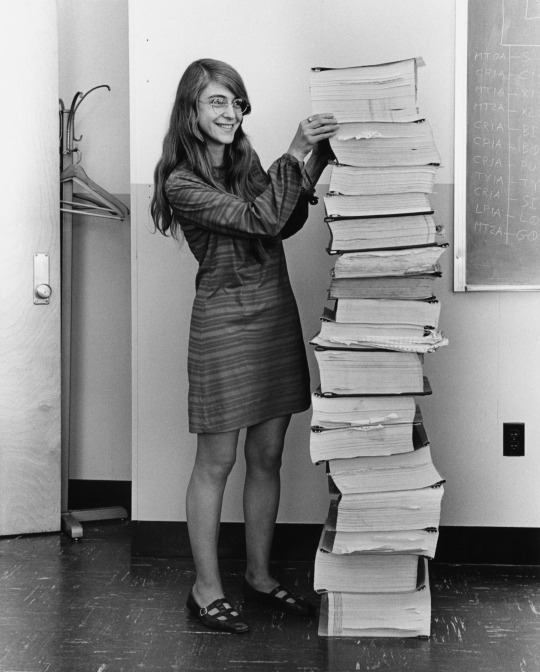
Margaret Hamilton, Director of the Apollo project Software Engineering Division, with a stack of papers containing the code to the Apollo Guidance Computer navigation software. The software that on this day, in 1969, guided Neil Armstrong and Buzz Aldrin when they landed on the Moon.
6K notes
·
View notes
Text
Spookoplathon Wrap-Up
Spookoplathon is a readathon hosted by Becca from Becca and the Books. This one is based on her old TBR game which in turn is based on Monopoly. You simply move around the board to get your prompts. Unlike other readathons I’ve participated in, there aren’t any teams, bonus prompts or a story. It’s just straight forward prompts to create your TBR. There are two different ways to play: roll as you…
#Adam Higginbotham#Asian History#Asian Legends#Asian-Inspired#Blogmas#Bookmas#Books#C. J. Cooke#C. J. Sansom#Challenger#Claribel A. Ortega#Elizabeth Lim#Ellie Keel#Fantasy#Fiction#Middle Grade#Mystery#NASA History#Nonfiction#Pierce Brown#Science Fiction#Space Shuttle Programme#Spookoplathon#Spookopoly#TBR Conquering#Thriller#Witchcraft#Witches#Young Adult
0 notes
Link
A few days before they left Skylab on Feb. 8, 1974, the final crew to occupy the station raised its...
0 notes
Text

Dr. Mae Jemison was the first African American woman to travel in space. Born on October 17, 1956, in Decatur, Alabama, and raised in Chicago, Illinois, Jemison’s journey into the stars is a testament to the power of dreams and determination. 🚀
#Astronauts#Mae Jemison#Black History#African American History#Womens History#Herstory#National Archives#NASA
7K notes
·
View notes
Text
So Venus is my favorite planet in the solar system - everything about it is just so weird.
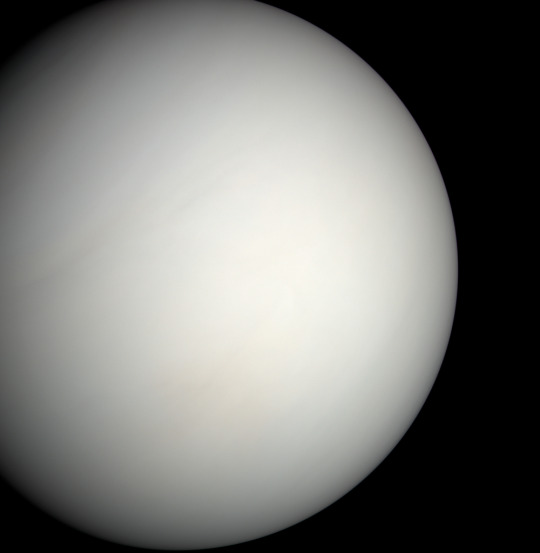
It has this extraordinarily dense atmosphere that by all accounts shouldn't exist - Venus is close enough to the sun (and therefore hot enough) that the atmosphere should have literally evaporated away, just like Mercury's. We think Earth manages to keep its atmosphere by virtue of our magnetic field, but Venus doesn't even have that going for it. While Venus is probably volcanically active, it definitely doesn't have an internal magnetic dynamo, so whatever form of volcanism it has going on is very different from ours. And, it spins backwards! For some reason!!
But, for as many mysteries as Venus has, the United States really hasn't spent much time investigating it. The Soviet Union, on the other hand, sent no less than 16 probes to Venus between 1961 and 1984 as part of the Venera program - most of them looked like this!
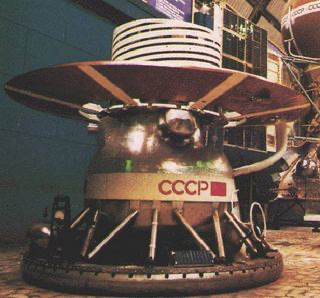
The Soviet Union had a very different approach to space than the United States. NASA missions are typically extremely risk averse, and the spacecraft we launch are generally very expensive one-offs that have only one chance to succeed or fail.
It's lead to some really amazing science, but to put it into perspective, the Mars Opportunity rover only had to survive on Mars for 90 days for the mission to be declared a complete success. That thing lasted 15 years. I love the Opportunity rover as much as any self-respecting NASA engineer, but how much extra time and money did we spend that we didn't technically "need" to for it to last 60x longer than required?
Anyway, all to say, the Soviet Union took a more incremental approach, where failures were far less devastating. The Venera 9 through 14 probes were designed to land on the surface of Venus, and survive long enough to take a picture with two cameras - not an easy task, but a fairly straightforward goal compared to NASA standards. They had…mixed results.
Venera 9 managed to take a picture with one camera, but the other one's lens cap didn't deploy.
Venera 10 also managed to take a picture with one camera, but again the other lens cap didn't deploy.
Venera 11 took no pictures - neither lens cap deployed this time.
Venera 12 also took no pictures - because again, neither lens cap deployed.
Lotta problems with lens caps.
For Venera 13 and 14, in addition to the cameras they sent a device to sample the Venusian "soil". Upon landing, the arm was supposed to swing down and analyze the surface it touched - it was a simple mechanism that couldn't be re-deployed or adjusted after the first go.
This time, both lens caps FINALLY ejected perfectly, and we were treated to these marvelous, eerie pictures of the Venus landscape:

However, when the Venera 14 soil sampler arm deployed, instead of sampling the Venus surface, it managed to swing down and land perfectly on….an ejected lens cap.
#space#space history#venus#NASA#Venera#spost#I will talk all day about venus#ask me about venus floating sky cities#unpopular opinion venus > mars#this is probably my favorite space history story#the surface of venus is made of lens caps#don't try to tell me the universe doesn't have a sense of humor#well#I guess its more that people have a sense of humor and we happen to live in the universe
28K notes
·
View notes
Text
"During NASA’s early years, it had not enacted any policies regarding religious observances in space. The issue first arose when John P. Donnelley, Assistant Administrator for Public Affairs at the Johnson Space Center, received an angry letter complaining that astronauts’ religious expression in space had been suppressed because of a lawsuit filed by Madalyn Murray O’Hair, the founder of American Atheists. She is perhaps best known for Murray v. Curlett, her successful challenge to the government’s policy of mandatory prayers and Bible in the Baltimore public schools. Many people do not know that O’Hair was also a leading Holocaust denier; for example, in a notorious article in American Atheist magazine, she argued that Auschwitz was little more than a labor camp, that less than 1.5 million Jews had been murdered in the Holocaust, and that Central Europe was substantially cleared of Jews because of emigration."
-Singer, S. J. (2024, January 12). Ilan Ramon’s Jewish Space Odyssey. The Jewish Press – JewishPress.com. https://www.jewishpress.com/sections/features/features-on-jewish-world/ilan-ramons-jewish-space-odyssey/2024/01/10/
1 note
·
View note
Text

One Giant Leap for Mankind
Millions of people around the globe will come together for the Paris 2024 Olympic Games later this month to witness a grand event—the culmination of years of training and preparation.
Fifty-five years ago this July, the world was watching as a different history-changing event was unfolding: the Apollo 11 mission was landing humans on the surface of another world for the first time. An estimated 650 million people watched on TV as Neil Armstrong reached the bottom of the ladder of the lunar module on July 20, 1969, and spoke the words, “That’s one small step for [a] man, one giant leap for mankind.”
While the quest to land astronauts on the Moon was born from the space race with the Soviet Union during the Cold War, this moment was an achievement for the whole of humanity. To mark the world-embracing nature of the Moon landing, several tokens of world peace were left on the Moon during the astronauts’ moonwalk.
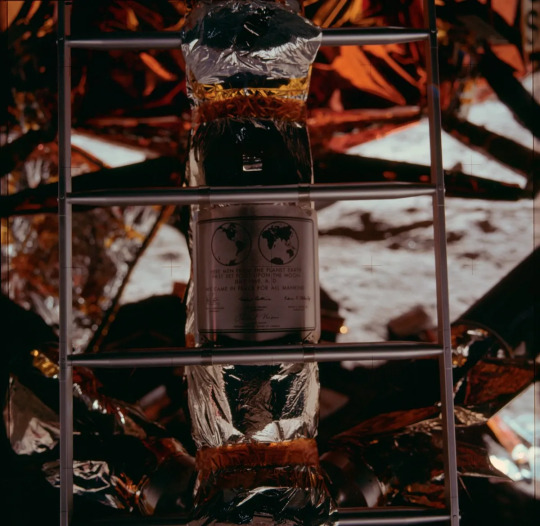
“We came in peace for all mankind”
These words, as well as drawings of Earth’s western and eastern hemispheres, are etched on a metal plaque affixed to a leg of the Apollo 11 lunar lander. Because the base of the lander remained on the Moon after the astronauts returned, it is still there today as a permanent memorial of the historic landing.

Microscopic messages from kings, queens, and presidents
Another artifact left on the Moon by the Apollo 11 astronauts is a small silicon disc etched with goodwill messages from leaders of 74 countries around the world. Each message was reduced to be smaller than the head of a pin and micro-etched on a disc roughly 1.5 inches (3.8 cm) in diameter. Thailand’s message, translated into English, reads: "The Thai people rejoice in and support this historic achievement of Earth men, as a step towards Universal peace."
Curious to read what else was inscribed on the disk? Read the messages.

An ancient symbol
The olive branch, a symbol of peace and conciliation in ancient Greek mythology, also found its way to the Moon in July 1969. This small olive branch made of gold was left on the lunar surface during Neil Armstrong and Buzz Aldrin’s 2.5-hour moonwalk. The olive branch also featured on the Apollo 11 mission patches sewed on the crew’s spacesuits. Designed in part by command module pilot Michael Collins, the insignia shows a bald eagle landing on the Moon holding an olive branch in its talons.

We go together
As NASA’s Artemis program prepares to again land astronauts on the Moon, including the first woman and the first person of color, this time we’re collaborating with commercial and international partners. Together we will make new scientific discoveries, establish the first long-term presence on the Moon, and inspire a new generation of explorers.
Is aerospace history your cup of tea? Be sure to check out more from NASA’s past at www.nasa.gov/history.
Make sure to follow us on Tumblr for your regular dose of space!
4K notes
·
View notes
Photo

May 8, 1980 – Astronaut Anna Fisher suited up for training in the Neutral Buoyancy Simulator at Marshall Space Flight Center in Alabama. (NASA)
2K notes
·
View notes
Text

Research alert! Two new studies out this week find that rock and dust samples retrieved by NASA from the asteroid Bennu in 2023 contain some of the building blocks for life on our planet. What’s more? There’s evidence of underground pools of saltwater that might have served as the “broth” for these compounds to interact and combine.
The studies, published in Nature Astronomy and Nature, are the first in-depth analyses of the minerals and molecules on Bennu, a remnant of a larger celestial body that formed about 4.5 billion years ago. The findings indicate that asteroids like Bennu may have seeded early Earth with the raw ingredients that led to the emergence of life. Read more in our latest blog post.
#science#amnh#museum#nature#natural history#fact of the day#did you know#space#universe#cosmos#earth#earth science#astronomy#asteroid#meteor#asteroid bennu#bennu#nasa#space exploration#life on earth
285 notes
·
View notes
Text


X-15 attached to U.S. Air Force B-52 for takeoff.
Image source: NASA
#aircraft#aviation#aeronautics#nasa#nasa history#hypersonic aviation#x15#b52#aviation history#aeronautical engineering#space stuff
7 notes
·
View notes
Text

























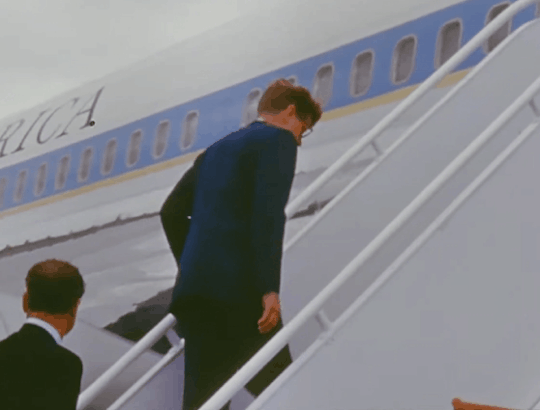
"I believe that this nation should commit itself to achieving the goal, before this decade is out, of landing a man on the moon and returning him safely to the earth."
president john f. kennedy touring NASA's launch operations center with wernher von braun 1962 at what is now called kennedy space center. (KSC). [pt.1]

#really liked doing this one but mobile tmblr is so asscheeks it took me half an hour to just rearrange them#like i was this close to kms#jfk#us presidents#us history#the kennedys#jack kennedy#potus#john f kennedy#history#vintage#americana#vintage americana#1960s#60s#nasa#space#ksc#presidents#us politics#gifs#gif#gifset#my gifs#pt.2 of this gifset will be posted soon .. theyve been queued#60s aesthetic#>gifs
191 notes
·
View notes
Text

In memory of the lost crew...
172 notes
·
View notes
Text
Hidden Figures
In honour of Black History Month, I'm starting to write book reviews about some of the nonfiction I'm reading
Note: As part of Black History Month, I’m trying something new: writing a book review on a new nonfiction fave. As many book reviews as I’ve written and posted, as many nonfiction books as I read, it’s not a genre I feel particularly comfortable with writing reviews for, but I thought I’d give it a whirl since I’m thinking about including more nonfiction content on my blogs other than the…

View On WordPress
#Biography#Black History Month#Book Review#Civil Rights Movement#Dorothy Vaughan#Family#History#Human Computers#IBM#Jim Crow#Katherine G. Johnson#Langley#Margot Lee Shetterly#Mary Jackson#Mathematics#Mercury Seven#NASA#NASA History#Nonfiction#Physics#Space Shuttle Programme#The South#Virginia
1 note
·
View note
Link
A few days before they left Skylab on Feb. 8, 1974, the final crew to occupy the station raised its...
0 notes